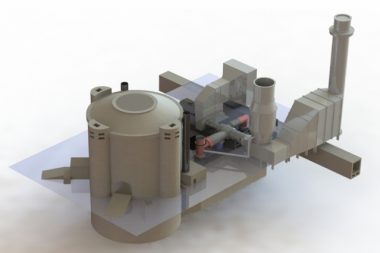
Researchers look to revive 3,500-year-old technology to take on energy storage
by Cleantech Canada Staff

MIT scientists are aiming to give a millennia-old ceramic invention a few modern tweaks and put it to work storing energy from clean power projects

The researchers say the technology can be used to store thermal energy generated at off-peak times. The heat can then be used to power industrial processes at facilities such as refineries. PHOTO: Walter Siegmund/Wikimedia
CAMBRIDGE, Mass.—Engineers are coming at the energy storage problem from every angle imaginable—from supersized batteries and molten salt, to biomimicry and underwater balloons.
A team of researchers at the Massachusetts Institute of Technology drawing inspiration from the 15th century B.C. is no exception.
The U.S. scientists have put together a plan to breathe fresh life into a bronze-age technology, originally developed for metal-smelting kilns, and use it to store energy generated by wind turbines, solar panels and nuclear power plants.
With a few modern tweaks, the team says firebricks, an invention of the ancient Hittites, can help smooth out overall electricity prices and make renewables more economical. A variant of conventional bricks, the ceramic technology has excellent heat retention properties, meaning it has the potential to hang onto energy generated by wind or solar long after the wind has ceased gusting and the sun has set.
The team, led by Charles Forsberg, a research scientist in MIT’s Department of Nuclear Science and Engineering, laid out a proposal to reignite firebricks in a paper published late last month in The Electricity Journal.

One possible configuration is to pair the energy storage technology with a nuclear power plant to provide “easily dispatchable” power. PHOTO: MIT
While the Hittites, a civilization that flourished around 3,500 years ago in what is today Turkey, used their clay firebricks to manufacture metals, the researchers are looking to use the technology to support industrial processes less directly.
Like other renewable energy storage schemes, the plan relies on taking advantage of cheap, off-peak electricity.
Similar to how charging a battery stores energy for later use, the system—dubbed FIRES, for Firebrick Resistance-heated Energy Storage—”charges” when excess electricity is used to heat a large mass of firebricks. If enclosed within an insulated casing, the firebricks are able to absorb a large amount of energy transferred through electric resistance heaters and retain that thermal energy for long periods of time. When electricity demand bounces back from its off-peak low, the stored energy can then be put to use.
Though the process for converting the firebricks’ thermal energy back into electricity is something a hurdle, Forsberg doesn’t view the issue as a dead-end for the technology.
Instead, he pointed to the enormous demand for thermal energy. In the U.S. and most other industrialized countries, for instance, he said demand for industrial heat actually outpaces total demand for electricity. This means the firebricks’ heat could be used to power industrial processes at facilities such as refineries or manufacturing plants.
Along with taking better advantage of clean power from intermittent renewable sources, the system would help level the overall cost of power by making electricity generated during off-peak times more valuable.
The MIT team also determined the cost of the Hittite-inspired technology would come in at somewhere between one-tenth and one-fortieth of battery storage or pumped hydro storage systems.
Despite the promising findings, the 3,500 year-old technology, unsurprisingly, does have its problems.
The challenge of converting the thermal energy back into electricity is one.
Getting the firebricks hot enough is another. Forsberg and his team of graduate students said existing resistance heaters can only heat the firebricks to temperatures of 850 C—far less than the temperatures the ceramics are able to withstand, and just over half of the 1,600 C required to produce electricity with conventional turbines. The researchers said one solution would be to use highly-conductive silicon carbide to build the firebrick, but they admit overcoming this heating issue is likely a problem for the next-generation of the technology.
For now, they’re focusing on making use of the stored heat.
Forsberg said the next step will be to set up a full-scale prototype of a FIRES system to test its performance in real-world conditions. He expects to line up a customer in the next few years and is looking at companies that use a large amount of thermal energy in their industrial processes and are located near a major wind farm; he cited an ethanol refinery as one example of a business that could take advantage of the technology.